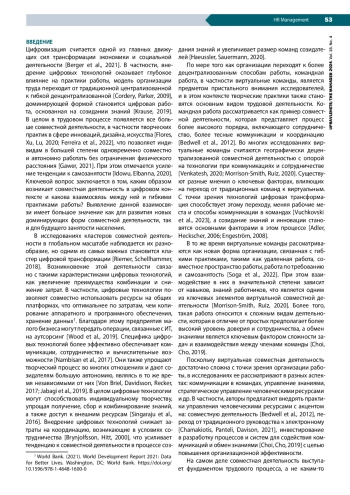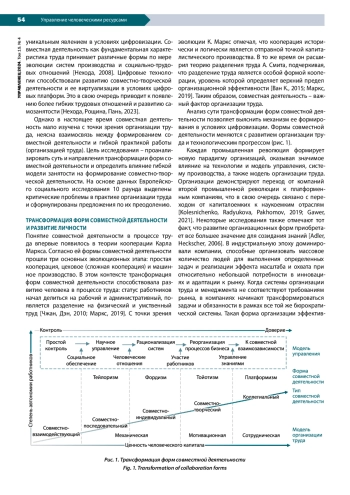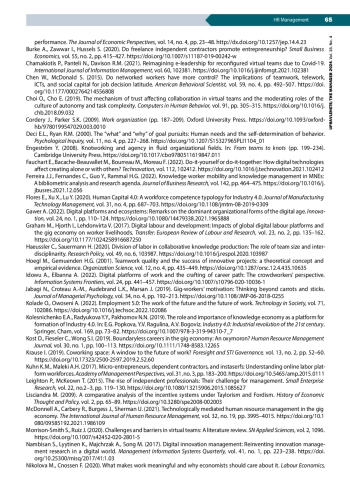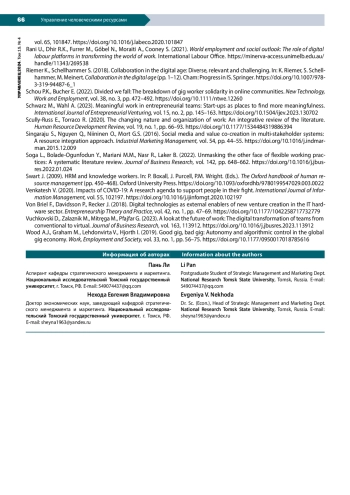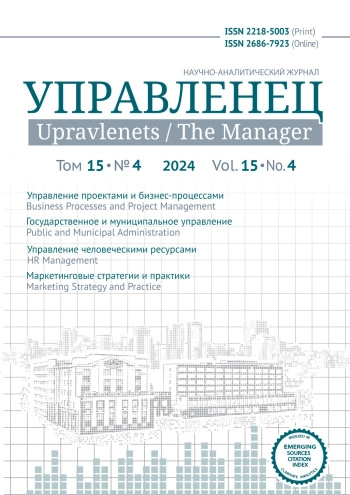Цифровизация и глобализация колоссально повлияли на организацию труда и взаимодействие работников в процессе трудовой деятельности. Совместно-творческая деятельность на платформах цифрового труда является новым феноменом, требующим углубленного рассмотрения. Статья посвящена изучению совместной деятельности как движущей силы эволюции организационных моделей труда, а также рассмотрению ее основных эффектов на рынке труда. Методологическую базу исследования составили теория кооперации и теория организации. Методы работы – эволюционный, статистический и регрессионный анализ. Информационной базой послужили открытые данные Европейского социального исследования (ESS) 10 раунда за 2020–2023 гг. Выявлены направления трансформации форм совместной деятельности: основные из них связаны с повышением ценности человека и наращиванием человеческого капитала, уровнем автономии работников. Организация труда, также претерпевающая значительные изменения, стимулирует развитие гибких практик работы. По результатам эмпирического анализа при активном использовании интернета самозанятые значительно увеличивают вероятность вовлечения в совместно-творческую деятельность, в частности, с ростом уровня образования. Следствием роста внутренней мотивации участников совместно-творческой деятельности является более высокая производительность труда. Результаты работы позволили выявить критическую проблему отсутствия практик управления человеческими ресурсами в условиях платформенной занятости. Разработка новой (гибкой) модели организации труда в соответствии с характеристиками и эффектами совместной деятельности может служить перспективным направлением дальнейших исследований
Идентификаторы и классификаторы
- SCI
- Социология
- УДК
- 316. Социология
Цифровизация считается одной из главных движущих сил трансформации экономики и социальной деятельности [Berger et al., 2021]. В частности, внедрение цифровых технологий оказываeт глубокое влияние на практики работы, модель организации труда переходит от традиционной централизованной к гибкой денцентрализованной [Cordery, Parker, 2009], доминирующей формой становится цифровая работа, основанная на созидании знаний [Krause, 2019]. В целом в трудовом процессе появляется все больше совместной деятельности, в частности творческих практик в сфере инноваций, дизайна, искусства [Flores, Xu, Lu, 2020; Ferreira et al., 2022], что позволяет индивидам в большей степени одновременно совместно и автономно работать без ограничения физического расстояния [Gawer, 2021].
Список литературы
1. Ван К. (2015). Теория кооперации Карла Маркса, развитие форм кооперации и взаимосвязь между собственностью и кооперацией // Экономист. № 6. C. 5-13. DOI: 10.16158/j.cnki.51-1312/f.2015.06.001
2. Маркс К. (2019). Капитал / пер. с нем. С. Алексеева. Москва: АСТ. Т. 1.
3. Нехода Е.В. (2008). Социальное развитие человека и изменение представлений о субъекте труда в системе трудовых отношений // Вестник Томского государственного университета. Экономика. T. 3, № 4. С. 23-45. EDN: KGCYEX
4. Нехода Е.В., Рощина И.В., Пань Ли. (2023). Эволюция форм совместной деятельности: от фордизма к экосистеме сотрудничества // Экономика труда. Т. 10, № 9. С. 1331-1351. DOI: 10.18334/et.10.9.118984 EDN: PQAVWA
5. Сюй Х., Ли Ш. (2005). Эволюция цепочки создания стоимости и координация в модульной организации // Индустриальная экономика Китая. № 11. C. 81-88. DOI: 10.19581/j.cnki.ciejournal.2005.11.011
6. Чжан А., Дэн С. (2010). Анализ разделения труда и человеческого развития в “Капитале” К. Маркса // Марксизм и реальность. № 4. C. 16-22. DOI: 10.15894/j.cnki.cn11-3040/a.2010.04.030
7. Adler P.S., Heckscher C. (2006). Towards collaborative community. The firm as a collaborative community: Reconstructing trust in the knowledge economy (pp. 11-105). New York: Oxford University Press. DOI: 10.1093/oso/9780199286034.003.0002
8. Arslan U., Erdil E. (2003). New technologies and changes in work organization: A survey. Science and Technology Policy Studies Center (STPS), Middle East Technical University, STPS Working Papers.
9. Banik N., Padalkar М. (2021). The spread of gig economy: Trends and effects. Foresight and STI Governance, vol. 15, no. 1, pp. 28-38. DOI: 10.17323/2500-2597.2021.1.19.29 EDN: HGFFYD
10. Bedwell W.L., Wildman J.L., DiazGranados D., Salazar M.R., Kramer W.S., Salas E. (2012). Collaboration at work: An integrative multilevel conceptualization. Human Resource Management Review, vol. 22, no. 2, pp. 128-145. DOI: 10.1016/j.hrmr.2011.11.007
11. Berger E.S., Von Briel F., Davidsson P., Kuckertz A. (2021). Digital or not - The future of entrepreneurship and innovation. Journal of Business Research, vol. 125, pp. 436-442. DOI: 10.1016/j.jbusres.2019.12.020 EDN: ZWYLQO
12. Bodrožić Z., Adler P.S. (2018). The evolution of management models: A Neo-Schumpeterian theory. Administrative Science Quarterly, vol. 63, no. 1, pp. 85-129. DOI: 10.1177/0001839217704811
13. Börnfelt P. (2023). Taylorism and Fordism. In: Work organisation in practice (pp. 25-73). Cham: Springer Nature. DOI: 10.1007/978-3-031-21667-1_2
14. Brynjolfsson E., Hitt L.M. (2000). Beyond computation: Information technology, organizational transformation and business performance. The Journal of Economic Perspectives, vol. 14, no. 4, pp. 23-48. DOI: 10.1257/jep.14.4.23 EDN: EPCEUR
15. Burke A., Zawwar I., Hussels S. (2020). Do freelance independent contractors promote entrepreneurship? Small Business Economics, vol. 55, no. 2, pp. 415-427. DOI: 10.1007/s11187-019-00242-w EDN: UNGCGE
16. Chamakiotis P., Panteli N., Davison R.M. (2021). Reimagining e-leadership for reconfigured virtual teams due to Covid-19. International Journal of Information Management, vol. 60, 102381. DOI: 10.1016/j.ijinfomgt.2021.102381 EDN: NHMEJH
17. Chen W., McDonald S. (2015). Do networked workers have more control? The implications of teamwork, telework, ICTs, and social capital for job decision latitude. American Behavioral Scientist, vol. 59, no. 4, pp. 492-507. DOI: 10.1177/0002764214556808
18. Choi O., Cho E. (2019). The mechanism of trust affecting collaboration in virtual teams and the moderating roles of the culture of autonomy and task complexity. Computers in Human Behavior, vol. 91, pp. 305-315. DOI: 10.1016/j.chb.2018.09.032
19. Cordery J., Parker S.K. (2009). Work organization (pp. 187-209). Oxford University Press. 10.1093/oxford- hb/9780199547029.003.0010. DOI: 10.1093/oxford-hb/9780199547029.003.0010
20. Deci E.L., Ryan R.M. (2000). The “what” and “why” of goal pursuits: Human needs and the self-determination of behavior. Psychological Inquiry, vol. 11, no. 4, pp. 227-268. DOI: 10.1207/S15327965PLI1104_01
21. Engeström Y. (2008). Knotworking and agency in fluid organizational fields. In: From teams to knots (pp. 199-234). Cambridge University Press. DOI: 10.1017/cbo9780511619847.011
22. Fauchart E., Bacache-Beauvallet M., Bourreau M., Moreau F. (2022). Do-it-yourself or do-it-together: How digital technologies affect creating alone or with others? Technovation, vol. 112, 102412. DOI: 10.1016/j.technovation.2021.102412
23. Ferreira J.J., Fernandes C., Guo Y., Rammal H.G. (2022). Knowledge worker mobility and knowledge management in MNEs: A bibliometric analysis and research agenda. Journal of Business Research, vol. 142, pp. 464-475. DOI: 10.1016/j.jbusres.2021.12.056 EDN: JAUTMB
24. Flores E., Xu X., Lu Y. (2020). Human Capital 4.0: A workforce competence typology for Industry 4.0. Journal of Manufacturing Technology Management, vol. 31, no. 4, pp. 687-703. DOI: 10.1108/jmtm-08-2019-0309 EDN: GOFKYD
25. Gawer A. (2022). Digital platforms and ecosystems: Remarks on the dominant organizational forms of the digital age. Innovation, vol. 24, no. 1, pp. 110-124. DOI: 10.1080/14479338.2021.1965888 EDN: XXOQTX
26. Graham M., Hjorth I., Lehdonvirta V. (2017). Digital labour and development: Impacts of global digital labour platforms and the gig economy on worker livelihoods. Transfer: European Review of Labour and Research, vol. 23, no. 2, pp. 135-162. DOI: 10.1177/1024258916687250
27. Haeussler C., Sauermann H. (2020). Division of labor in collaborative knowledge production: The role of team size and interdisciplinarity. Research Policy, vol. 49, no. 6, 103987. DOI: 10.1016/j.respol.2020.103987 EDN: QFRBIE
28. Hoegl M., Gemuenden H.G. (2001). Teamwork quality and the success of innovative projects: a theoretical concept and empirical evidence. Organization Science, vol. 12, no. 4, pp. 435-449. DOI: 10.1287/orsc.12.4.435.10635 EDN: DSEZNJ
29. Idowu A., Elbanna A. (2022). Digital platforms of work and the crafting of career path: The crowdworkers’ perspective. Information Systems Frontiers, vol. 24, pp. 441-457. DOI: 10.1007/s10796-020-10036-1 EDN: HXUTOH
30. Jabagi N., Croteau A.-M., Audebrand L.K., Marsan J. (2019). Gig-workers’ motivation: Thinking beyond carrots and sticks. Journal of Managerial Psychology, vol. 34, no. 4, pp. 192-213. DOI: 10.1108/JMP-06-2018-0255
31. Kolade O., Owoseni A. (2022). Employment 5.0: The work of the future and the future of work. Technology in Society, vol. 71, 102086. DOI: 10.1016/j.techsoc.2022.102086
32. Kolesnichenko E.A., Radyukova Y.Y., Pakhomov N.N. (2019). The role and importance of knowledge economy as a platform for formation of Industry 4.0. In: E.G. Popkova, Y.V. Ragulina, A.V. Bogoviz. Industry 4.0: Industrial revolution of the 21st century. Springer, Cham, vol. 169, pp. 73-82. DOI: 10.1007/978-3-319-94310-7_7
33. Kost D., Fieseler C., Wong S.I. (2019). Boundaryless careers in the gig economy: An oxymoron? Human Resource Management Journal, vol. 30, no. 1, pp. 100-113. DOI: 10.1111/1748-8583.12265
34. Krause I. (2019). Coworking space: A window to the future of work? Foresight and STI Governance, vol. 13, no. 2, pp. 52-60. DOI: 10.17323/2500-2597.2019.2.52.60 EDN: DRUTBC
35. Kuhn K.M., Maleki A.H. (2017). Micro-entrepreneurs, dependent contractors, and instaserfs: Understanding online labor platform workforces. Academyof Management Perspectives, vol. 31, no. 3, pp. 183-200. DOI: 10.5465/amp.2015.0111
36. Leighton P., McKeown T. (2015). The rise of independent professionals: Their challenge for management. Small Enterprise Research, vol. 22, no.2-3, pp. 119-130. DOI: 10.1080/13215906.2015.1085627
37. Lisciandra M. (2009). A comparative analysis of the incentive systems under Taylorism and Fordism. History of Economic Thought and Policy, vol. 2, pp. 65-89. DOI: 10.3280/spe2008-002003
38. McDonnell A., Carbery R., Burgess J., Sherman U. (2021). Technologically mediated human resource management in the gig economy. The International Journal of Human Resource Management, vol. 32, no. 19, pp. 3995-4015. DOI: 10.1080/09585192.2021.1986109 EDN: COTDCH
39. Morrison-Smith S., Ruiz J. (2020). Challenges and barriers in virtual teams: A literature review. SN Applied Sciences, vol. 2, 1096. DOI: 10.1007/s42452-020-2801-5
40. Nambisan S., Lyytinen K., Majchrzak A., Song M. (2017). Digital innovation management: Reinventing innovation management research in a digital world. Management Information Systems Quarterly, vol. 41, no. 1, pp. 223-238. :1.03. DOI: 10.25300/misq/2017/41
41. Nikolova M., Cnossen F. (2020). What makes work meaningful and why economists should care about it. Labour Economics, vol. 65, 101847. DOI: 10.1016/j.labeco.2020.101847 EDN: EGTXRA
42. Rani U., Dhir R.K., Furrer M., Gőbel N., Moraiti A., Cooney S. (2021). World employment and social outlook: The role of digital labour platforms in transforming the world of work. International Labour Office. https://minerva-access.unimelb.edu.au/handle/11343/269538.
43. Riemer K., Schellhammer S. (2018). Collaboration in the digital age: Diverse, relevant and challenging. In: K. Riemer, S. Schellhammer, M. Meinert. Collaboration in the digital age (pp. 1-12). Cham: Progress in IS. Springer. DOI: 10.1007/978-3-319-94487-6_1
44. Schou P.K., Bucher E. (2022). Divided we fall: The breakdown of gig worker solidarity in online communities. New Technology, Work and Employment, vol. 38, no. 3, pp. 472-492. DOI: 10.1111/ntwe.12260 EDN: LSZDBC
45. Schwarz M., Wahl A. (2023). Meaningful work in entrepreneurial teams: Start-ups as places to find more meaningfulness. International Journal of Entrepreneurial Venturing, vol. 15, no. 2, pp. 145-163. DOI: 10.1504/ijev.2023.130702 EDN: UWUXEU
46. Scully-Russ E., Torraco R. (2020). The changing nature and organization of work: An integrative review of the literature. Human Resource Development Review, vol. 19, no. 1, pp. 66-93. DOI: 10.1177/1534484319886394
47. Singaraju S., Nguyen Q., Niininen O., Mort G.S. (2016). Social media and value co-creation in multi-stakeholder systems: A resource integration approach. Industrial Marketing Management, vol. 54, pp. 44-55. DOI: 10.1016/j.indmarman.2015.12.009
48. Soga L., Bolade-Ogunfodun Y., Mariani M.M., Nasr R., Laker B. (2022). Unmasking the other face of flexible working practices: A systematic literature review. Journal of Business Research, vol. 142, pp. 648-662. DOI: 10.1016/j.jbusres.2022.01.024 EDN: FOZZAJ
49. Swart J. (2009). HRM and knowledge workers. In: P. Boxall, J. Purcell, P.M. Wright. (Eds.). The Oxford handbook of human resource management (pp. 450-468). Oxford University Press. DOI: 10.1093/oxfordhb/9780199547029.003.0022
50. Venkatesh V. (2020). Impacts of COVID-19: A research agenda to support people in their fight. International Journal of Information Management, vol. 55, 102197. DOI: 10.1016/j.ijinfomgt.2020.102197 EDN: UVXJKK
51. Von Briel F., Davidsson P., Recker J. (2018). Digital technologies as external enablers of new venture creation in the IT hardware sector. Entrepreneurship Theory and Practice, vol. 42, no. 1, pp. 47-69. DOI: 10.1177/1042258717732779
52. Vuchkovski D., Zalaznik M., Mitręga M., Pfajfar G. (2023). A look at the future of work: The digital transformation of teams from conventional to virtual. Journal of Business Research, vol. 163, 113912. DOI: 10.1016/j.jbusres.2023.113912
53. Wood A.J., Graham M., Lehdonvirta V., Hjorth I. (2019). Good gig, bad gig: Autonomy and algorithmic control in the global gig economy. Work, Employment and Society, vol. 33, no. 1, pp. 56-75. DOI: 10.1177/0950017018785616
Выпуск
Другие статьи выпуска
In a highly competitive Azerbaijani coffee shop market, knowing what drives consumer behaviour is crucial for marketers and businesses looking to separate out from the competition and encourage customer loyalty. The article examines the effects of brand image, product quality and price on consumer purchase intention. The study is based on marketing theory, consumer behavior theory and the concept of customer-centric marketing. The methods of logical-structural, quantitative, factor and regression analysis are used. Within the scope of the research, the data were collected through an online questionnaire. The data set of the study is represented by data from an online survey of 298 customers of coffee shops in the city of Baku, collected in the period April-May 2023. According to the findings of the study, brand image, product quality and price, which are independent variables, have a significant and positive effect on the dependent variable, the purchase intention. The results contribute to the understanding that businesses need to focus on building a strong brand image in order to increase consumer purchase intention. By gaining a deeper comprehension of the factors influencing the purchasing decisions of customers, businesses can create more effective marketing campaigns, increase their market share, develop a solid market position and build consumer loyalty in an increasingly competitive environment. The study adds to the ongoing discussion about customer-centric marketing by throwing new insight on the elements that influence consumer behaviour.
Alongside numerous benefits in business life (such as additional business opportunities, increased labour productivity), the Internet is responsible for adverse effects like cyberloafing in the workplace. Accessing the Internet for personal purposes during work hours is a prominent reason for counterproductive employee behaviour. The current theoretical background, however, is not sufficient to explain the causes of such behaviour. The article aims to identify the role of such factors as sparking leadership and perceived organizational support in preventing employees’ willingness to use their work time to engage in nonwork-related internet activities. To do so, five dimensions of cyberloafing are discussed: sharing, shopping, real-time updating, accessing online content, and gaming/gambling. Leadership theories, social exchange theory, and organizational support theory constitute the methodological basis of the research. The methods used are confirmatory factor analysis, and the PLS-SEM technique to reach a path model revealing the direct, indirect, and total relationships between the given dimensions. The data were collected from March to September 2023 through a face-to-face survey with 95 respondents from over 40 SMEs operating in Türkiye. The results revealed that perceived organizational support mediates the relationship between sparking leadership and sharing, shopping, and real-time updating dimensions of cyberloafing. The results point to the need for reconsidering organizational practices, values, and policies in a way that would foster employees’ well-being and happiness within the organization and mitigate their cyberloafing behaviour
Статья посвящена анализу развития одного из направлений в изучении государственного и муниципального управления, получившего в мировой литературе название логики публичных услуг (public service logic). Разработка данной концепции поможет внести вклад в совершенствование теории и практики предоставления публичных услуг в российской системе государственного и муниципального управления. Методология исследования основана на совокупности теорий государственного управления, концепциях логики доминирования услуг и логики доминирования публичных услуг. Работа строится на принципах методологического индивидуализма и междисциплинарного подхода, позволяющего использовать в анализе выводы существующих экономических исследований. Применялись методы сравнения, контент-анализа, систематизации. В результате выделены следующие теоретические лакуны, разработка которых станет основанием для развития положений логики публичных услуг: отсутствие в научном поле определения понятия «ценность публичных услуг» как формы со-производства услуги с участием продавца и потребителя; выявление особенностей поведения работников публичных (некоммерческих) организаций, оказывающих услуги, относящиеся к доверительным благам. Таким образом, логика публичных услуг фактически очерчивает такую важную сферу, как изучение механизмов со-создания ценности в публичной среде. Полученные результаты могут быть использованы для совершенствования государственной политики и разработки стратегических документов развития некоммерческих организаций, оказывающих публичные услуги
В исследованиях, посвященных инфляционным процессам, рассматриваются их сущность, факторы развития, вопросы антиинфляционного регулирования, но не уделяется внимание идентификации факторов инфляции в стратегических приоритетах регионального развития. При этом в экономической науке и государственной политике, осуществляемой на национальном и региональном уровнях, признается значимость влияния инфляции на экономическое развитие. Статья посвящена вопросам немонетарных факторов инфляции в регионах и разработке схемы формирования региональной политики в сфере их регулирования. Методологической базой исследования послужили теории регионального экономического развития, а также концептуальные положения теорий инфляции. Методы исследования – систематизация, функциональный и сравнительный анализ, дедукция. В работе идентифицированы положения стратегий социально-экономического развития субъектов РФ, входящих в состав Уральского макрорегиона, касающиеся регулирования немонетарных факторов развития инфляционных процессов. Выявленные аспекты сущности инфляции отражают воздействие ее немонетарных факторов на региональное экономическое развитие и требуют сопряженности антиинфляционной политики с направлениями деятельности органов регионального управления. Представлена концептуально-логическая модель формирования региональной политики в области регулирования немонетарных факторов инфляции в субъекте РФ, конкретизирующая стратегические приоритеты экономического развития, влияющие на региональные факторы инфляции. Модель демонстрирует, что именно государственные программы субъектов РФ являются основным инструментом регулирования немонетарных факторов инфляции в системе регионального управления. Она позволяет согласовать меры по регулированию цен в регионах с целями и задачами политики, направленной на развитие их экономики. Результаты исследования вносят вклад в понимание региональных факторов инфляции и могут использоваться органами государственной власти субъектов Российской Федерации в реализации стратегий социально-экономического развития.
Для достижения целей устойчивого социально-экономического развития и обеспечения технологического суверенитета Российской Федерации критически важен выбор методов эффективного управления технологическими проектами. Статья посвящена разработке нового инструментария нейросетевой классификации проектов технологического развития российских компаний и обоснованию актуальности применения методологии экстремального управления такими проектами. Методологическую базу исследования составили концепции управления жизненным циклом проекта и интеллектуального анализа данных. Методы исследования – интеллектуальный анализ текстов проектной документации с применением большой языковой модели, интеллектуальная классификация проектов на основе двумерной проекции многомерных кластеров с использованием Orange Data Mining. Информационной базой послужили нормативные документы в сфере научно-технологического развития Российской Федерации, открытые базы данных о проектах российских компаний. В работе разработан новый инструментарий нейросетевой классификации, основанный на большой языковой модели. Показано, что большинство проектов развития критических и сквозных технологий характеризуются низкой определенностью целей и решений, поэтому необходимо применять экстремальный подход к их управлению. Полученные результаты могут использоваться российскими компаниями для обоснования выбора модели управления проектами, а также экспертами-практиками при оценке проектов технологического развития
In the time of fast technology growth, digitalization is transforming the landscape of many businesses. However, the antecedents of digital adoption within small and medium-sized enterprises in crisis are yet not fully understood. This study’s objective is to pinpoint factors that influence entrepreneurs’ intentions to utilize digital technologies in times of COVID-19 crisis in the Russian Federation. The study is based on the theory of planned behaviour. The analytical procedures performed on the data involved logistic regression modelling. This research draws on the Russian part of the 2021 Global Entrepreneurship Monitor Database (GEM) Adult Population Survey which measures the level and nature of entrepreneurial activity in different countries. Perceived behavioural control was revealed to be a key determinant of the intention towards digital technologies’ adoption – entrepreneur’s perception of opportunities and self-efficacy positively affects their intention to adopt digital technologies during a crisis. Notably, previous experience with digital technologies had a negative impact during the crisis. Further, an individual’s age inversely affects their tendency to pursue digital entrepreneurial initiatives. The research extends the theory of planned behaviour to volatile contexts and signals how entrepreneurs can adapt to upheavals during crises through digitalization, thus advancing understanding of entrepreneurial behaviour under extremities
Статистика статьи
Статистика просмотров за 2025 год.
Издательство
- Издательство
- УрГЭУ
- Регион
- Россия, Екатеринбург
- Почтовый адрес
- 620144, Уральский ФО, Свердловская область, г. Екатеринбург, ул. 8 Марта/Народной Воли, д. 62/45
- Юр. адрес
- 620144, Уральский ФО, Свердловская область, г. Екатеринбург, ул. 8 Марта/Народной Воли, д. 62/45
- ФИО
- Силин Яков Петрович (РЕКТОР)
- E-mail адрес
- odo@usue.ru
- Сайт
- https://www.usue.ru/


